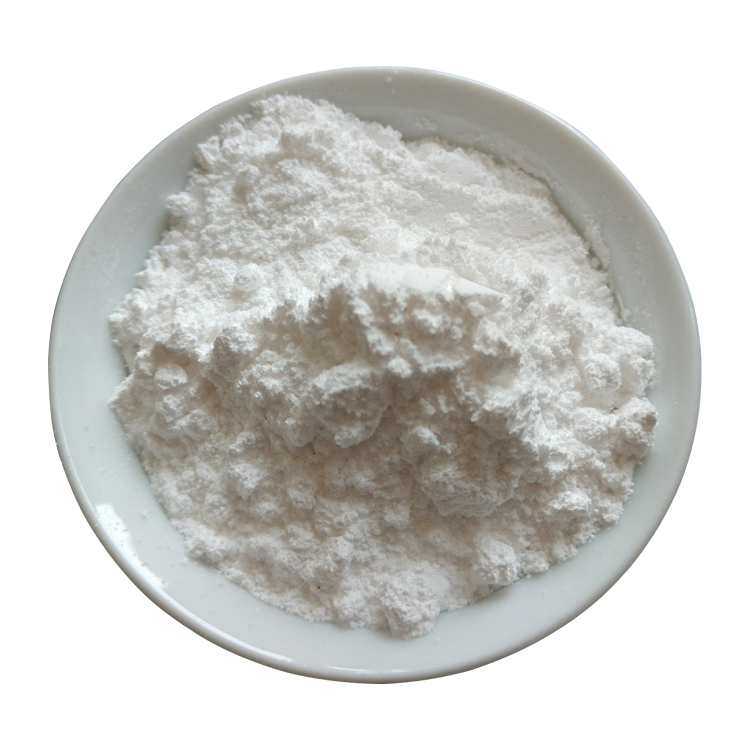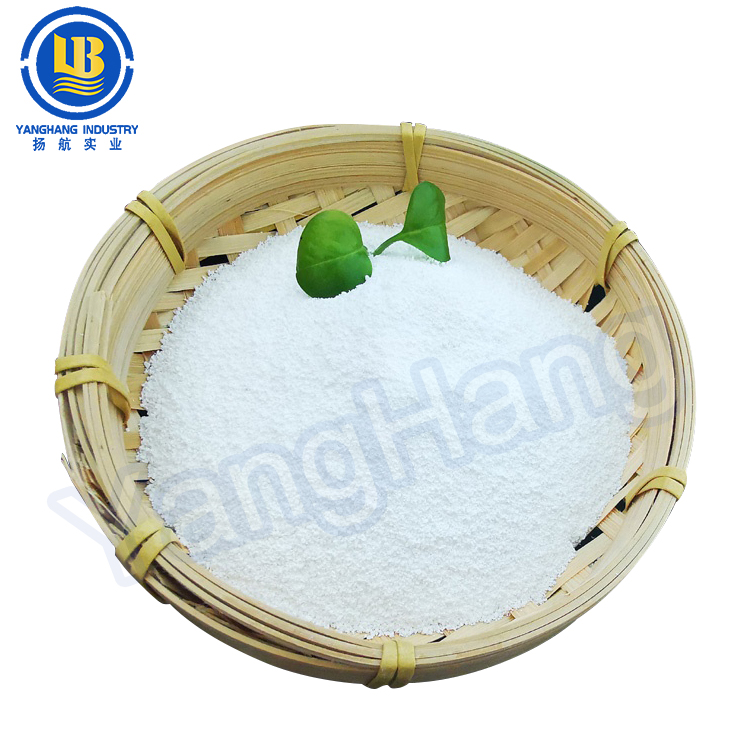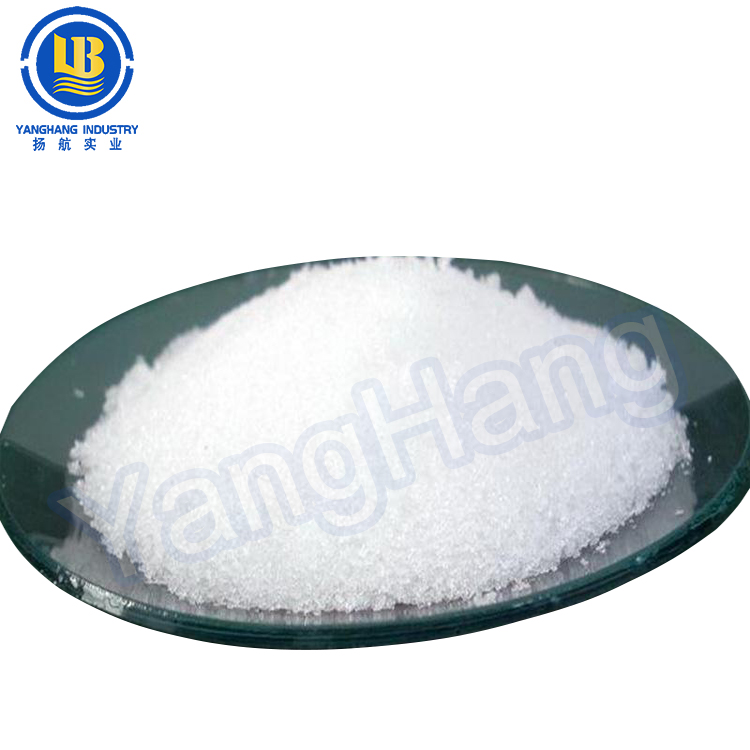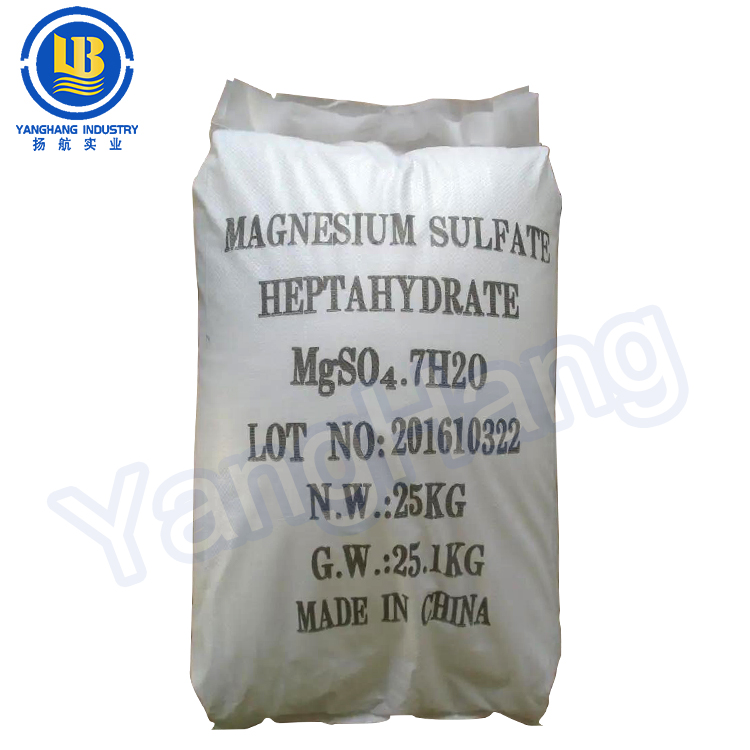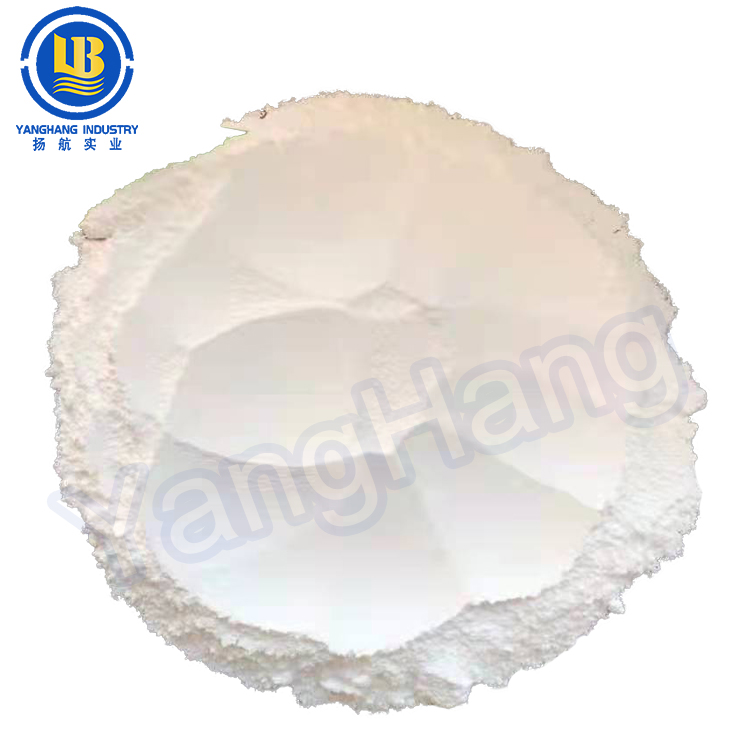Hainan Yanghang Industrial Co., Ltd.
34 years of focusing on R&D, production and sales of water treatment chemical products
 info@hnyhxd.com
info@hnyhxd.com
Magnesium sulfate anhydrous
Magnesium sulfate, also known as thiopicrin, bitter salt, laxative salt, and laxative salt, is a compound containing magnesium. The appearance is colorless or white easily weathered crystals or white powder. Odorless. It has a bitter and salty taste. Has deliquescence. Magnesium sulfate heptahydrate loses six molecules of water of crystallization at 150 ℃ and all water of crystallization at 200 ℃. The density of anhydrous material is 2.66, the melting point is 1124 ℃, and it decomposes simultaneously. Easily soluble in water, soluble in alcohol, ether, and glycerol, insoluble in acetone.
Magnesium sulfate is a commonly used chemical and drying reagent. Wet application of magnesium sulfate has anti-inflammatory and swelling reducing effects, which can reduce local tissue damage. Wet application of magnesium sulfate and wrapping with cling film is one of the effective methods for treating chemotherapy induced phlebitis. As a laxative in medicine, it can increase the osmotic pressure in the intestine, keep more water in the intestine, and increase the volume, thus stimulating the intestinal mucosa and promoting the catharsis effect. Used for constipation, intestinal detoxification, and a combination of insect repellents. And used for gallstones. It is also used in industries such as leather making, explosives, fertilizers, papermaking, porcelain, printing and dyeing. It is naturally produced. It can be prepared by the action of sulfuric acid on magnesium oxide, magnesium hydroxide, or magnesium carbonate.
Magnesium sulfate is an ideal raw material for manufacturing compound fertilizers. It can be mixed with nitrogen, phosphorus, and potassium to form compound fertilizers or mixed fertilizers according to different needs. It can also be mixed with one or more elements to form various fertilizers and photosynthetic micro fertilizers. Magnesium containing fertilizers are most suitable for acidic soil, peat soil, and sandy soil. After conducting field fertilization comparative experiments on nine crops, including rubber trees, fruit trees, tobacco leaves, legumes, potatoes, and grains, it was found that compound fertilizers containing magnesium can increase crops by 15-50% compared to compound fertilizers without magnesium. Magnesium sulfate is processed into laxatives, anticonvulsants, magnesium trisilicate, melamycin, acetylspiramycin, and muscle shakes in pharmaceuticals. In addition, it is used for industrial wastewater treatment to coagulate and settle waste water, making it meet the discharge standards.
Chemical formula: MgSO4
Molecular weight: 120.369
CAS Registry Number: 7487-88-9
EINECS login number: 231-298-2
Density: 1.07 g/mL at 20 ° C
Melting point: 1124 ℃
Water solubility: soluble in water, ethanol, and glycerol. Insoluble in acetone. Easy to absorb moisture
Appearance: Colorless rhombic crystal system
Preparation method:
Dry magnesium sulfate heptahydrate above 200 ℃ to remove all water of crystallization to generate anhydrous magnesium sulfate.
Purpose:
building materials
Magnesium sulfate can react with light burned powder to form magnesium oxysulfide cement after being dissolved in water. Magnesium oxysulfide cement has good fire resistance, insulation, durability, and environmental friendliness, and is applied in many fields such as fire door core panels, exterior wall insulation panels, silicon modified insulation panels, and fire resistant panels.
medicine
(1) Magnesium sulfate can inhibit the central nervous system, relax skeletal muscles, and have sedative, anti spastic, and intracranial pressure reducing effects. Commonly used to treat convulsions, eclampsia, uremia, tetanus, and hypertensive encephalopathy. Inject 10 milliliters of 10% magnesium sulfate into deep muscles or dilute with 5% glucose to a solution of 2% to 2.5% and slowly drip. However, it should be noted that direct intravenous injection or high-dose intramuscular injection of magnesium sulfate is very dangerous. Generally, a maximum of 15 milliliters of 25% magnesium sulfate can be used each time. When using, attention should be paid to observing the patient's breathing and blood pressure. Delayed knee reflexes are an important sign of sufficient magnesium ions.
(2) Magnesium plays an extremely important role in the metabolism of sugars and proteins. If children during their growth and development period experience indigestion and vitamin D use, magnesium salts should be supplemented.
(3) Magnesium has many physiological functions similar to potassium. Due to the clinical manifestations of magnesium deficiency being similar to potassium deficiency, magnesium deficiency is often overlooked. When symptoms do not improve after potassium supplementation during potassium deficiency, the possibility of magnesium deficiency should be considered first in order to promptly correct hypomagnesemia. Therefore, patients undergoing long-term infusion should pay attention to magnesium supplementation while supplementing potassium. Adding 1 gram of magnesium sulfate to daily infusion can prevent the occurrence of hypomagnesemia.
(4) When patients with cardiac insufficiency use digitalis, magnesium salts can be appropriately supplemented to prevent low magnesium from exacerbating the toxicity of digitalis. Magnesium salts are often effective in treating tachycardia in clinical practice.
(5) Oral magnesium sulfate is rarely absorbed in the intestine, therefore it does not have the aforementioned uses. But oral magnesium sulfate has good cathartic function, so magnesium sulfate is also called laxative salt. After the oral magnesium sulfate solution reaches the intestinal cavity, it has a certain osmotic pressure, so that the water in the intestine is not absorbed by the intestinal wall. The intestines retain a large amount of water, which can mechanically stimulate intestinal peristalsis and defecate. Therefore, magnesium sulfate can be used to treat constipation and abnormal intestinal fermentation; When used in combination with insect repellents, intestinal worms can be easily expelled. Dissolve 5-20 grams of magnesium sulfate in 100-400 milliliters of warm water each time, and take orally once in the morning. The concentration should not be too high, preferably 5%, otherwise defecation will be delayed.
(6) Magnesium sulfate can stimulate the duodenal mucosa, reflexively cause the relaxation of the common bile duct sphincter and the contraction of the gallbladder, thus promoting the emptying of the gallbladder and having the cholagogic effect. It can be used to treat cholecystitis and cholelithiasis, with 2-5 grams per dose, 3 times a day, taken orally before or between meals. Dilute 50% magnesium sulfate to 33% (high concentration), 5mL Tid.
(7) Magnesium sulfate can be used for gastrointestinal imaging.
(8) Anti inflammation and swelling removal: 50% solution of this product is used externally to apply heat to the affected area, which has the effect of anti-inflammatory and swelling removal.
Magnesium sulfate powder can be applied externally to reduce swelling, treat swelling after limb trauma, and help improve rough skin.
Magnesium sulfate is easily soluble in water and not absorbed when taken orally. Both magnesium ions and sulfate ions in the aqueous solution are not easily absorbed by the intestinal wall, which increases the osmotic pressure in the intestine, and the water in the body fluid moves towards the intestinal cavity, increasing the volume of the intestinal cavity and expanding the intestinal wall, thus stimulating the afferent nerve endings of the intestinal wall, reflexively causing increased intestinal peristalsis and catharsis. Its effect is fast and strong in all intestinal segments. Used as a cathartic and duodenal drainage agent.
Magnesium sulfate intravenous injection and intramuscular injection are mainly used for anticonvulsant therapy. It can cause vasodilation, leading to a decrease in blood pressure. Due to the central inhibitory effect and skeletal muscle relaxation effect of magnesium sulfate, it is mainly used in clinical practice to alleviate seizures such as eclampsia and tetanus, and also for the treatment of high blood pressure crises. It is also used to detoxify barium salts.
industry
Used in industries such as leather making, explosives, fertilizers, papermaking, porcelain, printing and dyeing materials, lead-acid batteries, etc. Magnesium sulfate, like other minerals such as potassium, calcium, amino acid salts, and silicates, can be used as a bath salt.
agriculture
Fertilizer: In agriculture and horticulture, magnesium sulfate is used to improve magnesium deficient soils (magnesium is a fundamental element of chlorophyll molecules), and is most commonly used for potted plants or magnesium containing crops such as potatoes, roses, tomatoes, chili peppers, and hemp. The advantage of applying magnesium sulfate over other magnesium sulfate soil amendments (such as dolomitic lime) is its high solubility.
Feed: Feed grade magnesium sulfate is used as a supplement for magnesium in feed processing. Magnesium is an indispensable factor involved in the osteogenic process and muscle contraction in livestock and poultry, and is an activator of various enzymes in the body. It plays an extremely important role in material metabolism and neural function in livestock and poultry. If the body of livestock and poultry lacks magnesium, it can lead to material metabolism and neurological dysfunction, supply imbalance, affect the growth and development of livestock and poultry, and even lead to death.
First aid measures:
Skin contact: Remove contaminated clothing and rinse with flowing water.
Eye contact: Lift the eyelids and rinse with flowing water or physiological saline. Seek medical attention.
Inhalation: Quickly remove from the scene to a place with fresh air. Maintain unobstructed respiratory tract. If breathing is difficult, administer oxygen. If breathing stops, immediately perform artificial respiration. Seek medical attention.
Ingestion: Drink plenty of warm water to induce vomiting. Seek medical attention.
Storage and transportation characteristics:
Transportation precautions: The packaging should be complete during transportation and the loading should be stable. During transportation, it is necessary to ensure that the container does not leak, collapse, fall, or be damaged. It is strictly prohibited to mix and transport with oxidants, edible chemicals, etc. During transportation, it is necessary to prevent exposure to sunlight, rain, and high temperatures. The vehicle should be thoroughly cleaned after transportation. During road transportation, it is necessary to follow the prescribed route.


